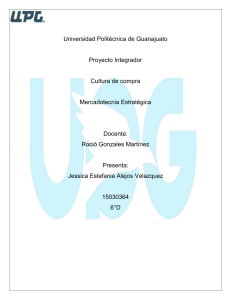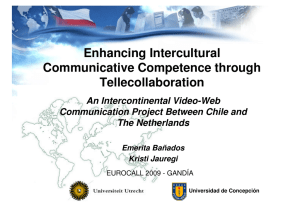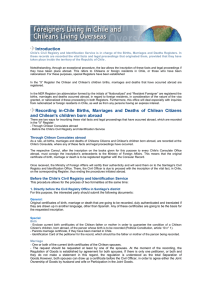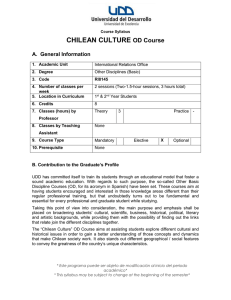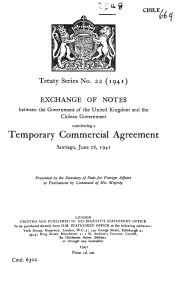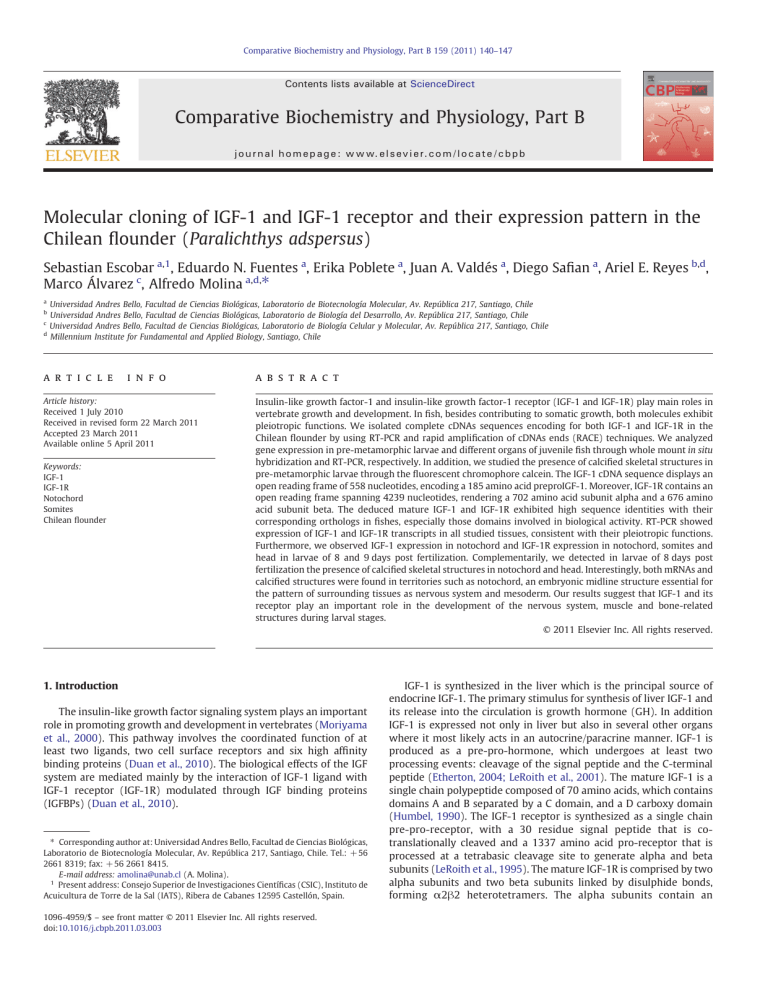
Comparative Biochemistry and Physiology, Part B 159 (2011) 140–147 Contents lists available at ScienceDirect Comparative Biochemistry and Physiology, Part B j o u r n a l h o m e p a g e : w w w. e l s ev i e r. c o m / l o c a t e / c b p b Molecular cloning of IGF-1 and IGF-1 receptor and their expression pattern in the Chilean flounder (Paralichthys adspersus) Sebastian Escobar a,1, Eduardo N. Fuentes a, Erika Poblete a, Juan A. Valdés a, Diego Safian a, Ariel E. Reyes b,d, Marco Álvarez c, Alfredo Molina a,d,⁎ a Universidad Andres Bello, Facultad de Ciencias Biológicas, Laboratorio de Biotecnología Molecular, Av. República 217, Santiago, Chile Universidad Andres Bello, Facultad de Ciencias Biológicas, Laboratorio de Biología del Desarrollo, Av. República 217, Santiago, Chile Universidad Andres Bello, Facultad de Ciencias Biológicas, Laboratorio de Biología Celular y Molecular, Av. República 217, Santiago, Chile d Millennium Institute for Fundamental and Applied Biology, Santiago, Chile b c a r t i c l e i n f o Article history: Received 1 July 2010 Received in revised form 22 March 2011 Accepted 23 March 2011 Available online 5 April 2011 Keywords: IGF-1 IGF-1R Notochord Somites Chilean flounder a b s t r a c t Insulin-like growth factor-1 and insulin-like growth factor-1 receptor (IGF-1 and IGF-1R) play main roles in vertebrate growth and development. In fish, besides contributing to somatic growth, both molecules exhibit pleiotropic functions. We isolated complete cDNAs sequences encoding for both IGF-1 and IGF-1R in the Chilean flounder by using RT-PCR and rapid amplification of cDNAs ends (RACE) techniques. We analyzed gene expression in pre-metamorphic larvae and different organs of juvenile fish through whole mount in situ hybridization and RT-PCR, respectively. In addition, we studied the presence of calcified skeletal structures in pre-metamorphic larvae through the fluorescent chromophore calcein. The IGF-1 cDNA sequence displays an open reading frame of 558 nucleotides, encoding a 185 amino acid preproIGF-1. Moreover, IGF-1R contains an open reading frame spanning 4239 nucleotides, rendering a 702 amino acid subunit alpha and a 676 amino acid subunit beta. The deduced mature IGF-1 and IGF-1R exhibited high sequence identities with their corresponding orthologs in fishes, especially those domains involved in biological activity. RT-PCR showed expression of IGF-1 and IGF-1R transcripts in all studied tissues, consistent with their pleiotropic functions. Furthermore, we observed IGF-1 expression in notochord and IGF-1R expression in notochord, somites and head in larvae of 8 and 9 days post fertilization. Complementarily, we detected in larvae of 8 days post fertilization the presence of calcified skeletal structures in notochord and head. Interestingly, both mRNAs and calcified structures were found in territories such as notochord, an embryonic midline structure essential for the pattern of surrounding tissues as nervous system and mesoderm. Our results suggest that IGF-1 and its receptor play an important role in the development of the nervous system, muscle and bone-related structures during larval stages. © 2011 Elsevier Inc. All rights reserved. 1. Introduction The insulin-like growth factor signaling system plays an important role in promoting growth and development in vertebrates (Moriyama et al., 2000). This pathway involves the coordinated function of at least two ligands, two cell surface receptors and six high affinity binding proteins (Duan et al., 2010). The biological effects of the IGF system are mediated mainly by the interaction of IGF-1 ligand with IGF-1 receptor (IGF-1R) modulated through IGF binding proteins (IGFBPs) (Duan et al., 2010). ⁎ Corresponding author at: Universidad Andres Bello, Facultad de Ciencias Biológicas, Laboratorio de Biotecnología Molecular, Av. República 217, Santiago, Chile. Tel.: + 56 2661 8319; fax: + 56 2661 8415. E-mail address: [email protected] (A. Molina). 1 Present address: Consejo Superior de Investigaciones Científicas (CSIC), Instituto de Acuicultura de Torre de la Sal (IATS), Ribera de Cabanes 12595 Castellón, Spain. 1096-4959/$ – see front matter © 2011 Elsevier Inc. All rights reserved. doi:10.1016/j.cbpb.2011.03.003 IGF-1 is synthesized in the liver which is the principal source of endocrine IGF-1. The primary stimulus for synthesis of liver IGF-1 and its release into the circulation is growth hormone (GH). In addition IGF-1 is expressed not only in liver but also in several other organs where it most likely acts in an autocrine/paracrine manner. IGF-1 is produced as a pre-pro-hormone, which undergoes at least two processing events: cleavage of the signal peptide and the C-terminal peptide (Etherton, 2004; LeRoith et al., 2001). The mature IGF-1 is a single chain polypeptide composed of 70 amino acids, which contains domains A and B separated by a C domain, and a D carboxy domain (Humbel, 1990). The IGF-1 receptor is synthesized as a single chain pre-pro-receptor, with a 30 residue signal peptide that is cotranslationally cleaved and a 1337 amino acid pro-receptor that is processed at a tetrabasic cleavage site to generate alpha and beta subunits (LeRoith et al., 1995). The mature IGF-1R is comprised by two alpha subunits and two beta subunits linked by disulphide bonds, forming α2β2 heterotetramers. The alpha subunits contain an S. Escobar et al. / Comparative Biochemistry and Physiology, Part B 159 (2011) 140–147 extracellular ligand-binding domain and the beta subunits are composed of a single transmembrane domain and a highly conserved intracellular TK domain (LeRoith et al., 1995). At a cellular level the IGF-1 acts in an autocrine/paracrine manner to control physiological processes such as protein synthesis, cell proliferation, differentiation, and apoptosis (Jones and Clemmons, 1995). In vertebrates, the insulin-like growth factor system has been shown to be unique among growth factors, playing an important role in the early patterning and muscle development. Over the past decade, IGF-1 cDNAs' partial and complete sequences have been isolated from several fishes, including Teleost (Wood et al., 2005), Elasmobranchs (Duguay et al., 1995) and Agnathans (Nagamatsu et al., 1991) revealing an evolutionary conserved sequence (Wood et al., 2005). In zebrafish four distinct genes encoding IGF peptides (IGF-1a, IGF-1b, IGF-2a, and IGF-2b) have been cloned and identified revealing an important role in the regulation of midline and notochord development during embryogenesis (Zou et al., 2009). Additionally full length and partial cDNA sequences encoding IGF-1R have been reported in several teleost such us turbot (Elies et al., 1999), zebrafish (Ayaso et al., 2002; Maures et al., 2002), Japanese flounder (Nakao et al., 2002), and seabream (Perrot et al., 1999) among others. To date the duplication of two functional IGF-1R genes (IGF-1Ra and IGF-1Rb) in Japanese flounder (Nakao et al., 2002) and zebrafish (Maures et al., 2002) has been reported, with a differential expression pattern suggesting different roles in the regulation of growth and development of vertebrates. Chilean flounder (Paralichthys adspersus) is a marine fish widely distributed throughout the Chilean coast, which is raising a high economic value. However, slow growth rate has been recognized as a major problem in marine fish, increasing the final production cost. Thus, the viability to farm these species requires new knowledge in order to develop new strategies to improve fish growth (Delgado et al., 2008). In this regard, considering the relevant function of the IGF-1 signaling pathways in promoting growth and skeletal muscle development in fish, we describe here as a first approximation, the isolation and characterization of the full length IGF-1R and IGF-1 cDNAs, which include the codifying regions and the 5′- and 3′-untranslated regions of both transcripts. Additionally, we studied the mRNA expression in premetamorphic larvae and in different tissues of juvenile fish and the presence of calcified skeletal structures in larvae. 2. Materials and methods 2.1. Fish Chilean flounder (P. adspersus) were collected from the Centro de Investigaciones Marinas de Quintay (CIMARQ) (V Region, Valparaíso, Chile). The fish were maintained under natural temperature and photoperiod conditions corresponding to geographic localization of CIMARQ (33°13′S 71°38′W) and were fed twice daily with turbot pellet (Biomar, Chile). Juvenile fish (average mass 200 ± 10 g) were sacrificed through an overdose of anesthetic (3-aminobenzoic acid ethyl ester) (300 mg/L). The heart, kidney, gills, intestine, gonads, spleen, liver, stomach, white muscle and red muscle tissues were collected, directly frozen in liquid nitrogen and stored at −80 °C. Larvae were obtained after in vitro fertilization of eggs by male broodstock sperm. Embryos were maintained under intensive-culture conditions in conic larval culture tanks at 19 °C ± 2 °C. Larvae at pre-metamorphic stages were collected, fixed in 4% paraformaldehyde in PBS for 2 h at 4 °C, dehydrated in methanol and stored at −20 °C. 2.2. RT-PCR and cDNA cloning Total RNA was isolated from liver using Trizol reagent following the manufacturer protocols (Invitrogen, Carlsbad, CA, USA). A total of 5 μg 141 of RNA previously treated with DNase I (1 U/μL) was used for RNA firststrand cDNA using M-MLV reverse transcriptase (Invitrogen). PCR primers for cloning IGF-1 receptor and IGF-1 cDNA (Table A1, supplemental material) were designed from a consensus analysis of conserved coding regions of known IGF-1 receptor and IGF-1 ligand sequences from Japanese flounder, turbot and zebrafish. The PCR reaction, containing the cDNA template, 10 μL of 10X PCR buffer, 200 μM of each dNTP, 1 μg of the forward and reverse primers, and 2.5 U of Pfu Taq DNA polymerase (Promega, Madison, WI, USA), was carried out in a final volume of 50 μL. The IGF-1R and IGF-1 PCR products were cloned into the pGEM-T easy vector (Promega) and the clones were completely sequenced and assembled in only one sequence. The IGF-1R and IGF-1 full-length 5′-terminal region, including the transcription start site, was completed using the First Choice RLM-RACE kit (Ambion, Austin, TX, USA) according to the manufacturer's instructions. Briefly, a RT-PCR with an adapter primer and the IGF-1R gene specific primers (5IGF-1ROP 5′-GACAGACAGCATCAGACCCCAAAACA-3′, 5IGF-1RIP 5′-TGCCAGTCACAGGATACTTG3 ′ ) o r t h e I GF - 1 g en e s p ec i fic p r i m er s ( 5 I GF - 1 O P 5 ′ AAAAGCCTCTCTCTCCACACAC-3′, 5IGF-1IP 5′-TCTCTCCACACACACAAACTGCAG-3′) using a CIP/TAP mRNA as a template in a nested reaction. The IGF-1R 3′-region was obtained using the gene-specific primers (3IGF-1ROP 5′-ACCCAGGTCCTACCCCCACTCAAA-3′, 3IGF-1RIP 5′-TTCTCCCTTCGGGGAAAT GAGTTT-3′). The IGF-1 3′-region was obtained using the gene-specific primers (3IGF-1OP 5′-ACCTGGAGATGTACTGTGCAC-3′, 3IGF-1IP 5′-CAAGACTAGCAAGGCAGCTC-3′). 2.3. Sequence analysis Amino acid sequences translated from the cDNA sequence were compared with sequences in the GenBank public database, by using the NCBI-BLAST application (http://www.ncbi.nlm.nih.gov/blast). Multiple amino acid sequences' alignment for the IGF-1 receptor and IGF-1 were performed using clustalW (Thompson et al., 1994). 2.4. Tissue expression and distribution of IGF-1 receptor and IGF-1 by semi quantitative RT-PCR analysis Total RNA was extracted from juvenile Chilean flounder (P. adspersus) using the RNeasy Mini Kit (Qiagen, Austin, TX, USA) from several tissues (white muscle, red muscle, liver, spleen, kidney, intestine, stomach, heart, gill and gonad) following manufacturer recommendations. RNA was quantified using NanoDrop technology with the Epoch Multi-Volume Spectrophotometer System (BioTek, Winooski, VT, USA). Assessment of RNA quality was performed by electrophoresis on a 1.2% formaldehyde agarose gel containing ethidium bromide. Only RNAs with an A260/280 ratio between 1.9 and 2.1 were used for cDNA synthesis. 800 ng of RNA was reverse transcribed into cDNA for 30 min at 42 °C using a Quantitect reverse transcription kit (Qiagen) as per manufacturer's recommendations. PCR was performed using 7.5 μL of Go taq green master mix (Promega), 6 μL of cDNA (50-fold dilution), and 500 nM of each primer. Gene-specific primers were used to amplify a fragment of 400 bp for IGF-1 (F: CTTCAAGAGTGCGATGTGCTGT; R: GGCTGCTGTGCTGTCCTACG), 645 bp for IGF-1R (F: GACCTTGCTCTCAAGTGCAC; R: CTAACGAGACAACGAGTCACA) and 679 bp for β-actin (F: GTCCCTGTATGCCTCTGGTCG; R: CAGGAGTACGATGAGTCTGGA), which was used as constitutive gene expression control. Thermal cycling conditions for IGF-1, IGF-1R and β-actin were the following: initial activation of 10 min at 95 °C, followed by 35 (IGF-1) or 33 (IGF-1R), or 23 (β-actin) cycles of 30 s at 95 °C; 30 s at 60 (IGF-1) or 52 °C (IGF-1R) or 57 °C (β-actin); 30 s (IGF-1) or 45 s (IGF1R and β-actin) at 72 °C, and a final extension of 10 min at 72 °C. Semi quantitative expression analyses were carried out through densitometric analyses of the bands using the Image J program (National Institutes of Health (NIH), USA), performing a ratio of the gene of interest (IGF-1 or 142 S. Escobar et al. / Comparative Biochemistry and Physiology, Part B 159 (2011) 140–147 IGF-1R) with the gene of constitutive expression (β-actin). Results are presented as arbitrary units (A.U) and expressed as means±SE (n=3). Statistical analyses were carried out with the software STATISTICA 7 (Tulsa, OK, USA) using the general linear model (GLM) with repeated measurements ANOVA followed by Tukey's analyses as post-test. A probability level of P b 0.05 was used to indicate significance. 2.5. Whole-mount in situ hybridization A 1604 bp fragment corresponding to the IGF-1R coding sequence was amplified by PCR using gene-specific primers (5′-GCCTTTCCAGAACATCACAGAG-3′, 5′-TTGAACTCCTTCATGACGGAGG-3′) and the same cDNA described before as a template. This fragments were cloned into pGEM-T Easy Vector System (Promega) originating the pL3F4R1604, which was linearized with NdeI or SpHI restriction enzymes to synthesized sense (control) and antisense riboprobes DIG-UTP-labeled (Roche Diagnostics, Mannheim, Germany) using SP6 and T7 RNA polymerases (Promega) respectively. A 454 bp fragment corresponding to the IGF-1 coding sequence was amplified by PCR using gene-specific primers (5′CCTCTCCACTACTGCTGTGTGTC-3′, 5′-ATGTCTGTGTGGCGTTGTGCAC-3′) and the same cDNA described before as a template. This fragments were cloned into pGEM-T Easy Vector System (Promega) originating the pLeigfI454, which was linearized with NdeI or NcoI restriction enzymes to synthesized sense (control) and antisense riboprobes DIG-UTP-labeled (Roche Diagnostics, Mannheim, Germany) using SP6 and T7 RNA polymerases (Promega) respectively. The riboprobes were purified using mini Quick Spin Columns (Roche Diagnostics) to eliminate unincorporated labeled nucleotides. Whole mount in situ hybridization was performed according to Fuentes et al. (2008). Briefly, after bleaching treatment, embryos and larvae were pre-hybridized overnight at 60 °C in hybridization buffer and then incubated overnight at 65 °C in hybridization buffer including 50 ng of sense or antisense IGF-1R and IGF-1 riboprobes. After hybridization, embryos and larvae were washed in a solution with decreasing formamide concentration in 2X SSC, followed by two wash-steps with SSC 0.2X for 30 min at 65 °C. Larvae were incubated for 4 h in a blocking buffer at room temperature. For immunodetection, samples were incubated overnight at 4 °C with anti-digoxigenin-AP antibody (Roche Diagnostics). After washes with PBT to eliminate nonbounded antibodies and three additional washes with AP-buffer, stains were performed with NBT/BCIP (75 mg/mL and 50 mg/mL, respectively) (Promega) for 6 h at 37 °C. The experiment was performed four times using n =15 individuals from each developmental stages. After in situ hybridization, samples were observed in a Leica MZ12.5 stereomicroscope and photographed with a Leica DF300 camera. 2.6. Larvae calcein staining Calcein immersion was carried out as described by Du et al. (2001). Briefly, Chilean flounder larvae were netted and immersed in calcein (Sigma-Aldrich Chemical, St. Louis, MO, USA) solution (0.2%) in Petri dishes for 10 min. After the immersion, larvae were rinsed a number of times in fresh water, and then allowed to set for 10 min to allow the excess, unbound calcein to diffuse. The larvae were mounted on glass slides with methyl-cellulose (3%). Observation was carried in Leica MZ12.5 stereomicroscope with a fluorescence filter set and photographed with a Leica DF300 camera. Composite images of the larvae were produced with Image J program (National Institutes of Health (NIH), USA). 3. Results 3.1. Cloning and characterization of the IGF-1R and IGF-1 cDNA The complete Chilean flounder IGF-1R and IGF-1 cDNA sequences (cfIGF-1R and cfIGF-1) were obtained using RT-PCR coupled to RACE method (GenBank number FJ438475 and EU017533, respectively). The length of the complete IGF-1R cDNA sequence was 5033 bp, which includes a 622 bp 5′-untranslated region (UTR), an open reading frame (ORF) of 4239 bp and a 172 bp 3′-UTR. The ORF encodes a putative protein of 1412 amino acid residues (Fig. A1, supplemental material). The sequence analysis reveals that the Chilean flounder cDNA IGF-1 receptor is organized into several major domains including a signal peptide sequence of 30 amino acids, an extracellular alpha subunit of 702 amino acids and an intracellular beta subunit of 676 amino acids (Fig. A1, supplemental material). The length of the complete IGF-1 cDNA sequence is 980 bp, which includes a 152 bp 5′-untranslated region (UTR), an open reading frame (ORF) of 558 bp and a 270 bp 3′-UTR, encoding a putative protein of 185 amino acid residues (Fig. A2, supplemental material). The comparative IGF-1 sequence analysis with other species reveals that the ligand deduced protein is subdivided into six structural domains, including a signal peptide sequence of 44 amino acids, the B domain of 29 amino acids, the C domain of 10 amino acids, the A domain of 21 amino acids, the D domain of 8 amino acids and the E domain of 73 amino acids (Fig. A2, supplemental material). Amino acid sequence alignment of cfIGF-1R (FJ438475.1) with different vertebrate orthologs, including mammalian (human, X04434.1 and rat, AF056187.1), birds (chicken, AJ223164.1), amphibians (Xenopus, AF055980.1) and fish (zebrafish, AF400275.1 and Japanese flounder, AB065098.1) was performed (Fig. A1, supplemental material). The cfIGF-1R sequence was found to have 61%, 61%, 63%, and 62% of identity with IGF-1R of human, rat, chicken and Xenopus, respectively. Higher degrees of identity were found with other fish IGF-1R sequences, including a 74% with zebrafish and as much as 97% with another fish belonging to the Paralichthys genus, the Japanese flounder (Fig. 1A). A potential proteolytic cleavage sequence R-X-R-R was conserved in all the species compared. The cysteine-rich domain, into the alpha subunit of the cfIGF-1R, contains 24 cysteine residues, which were also observed in all vertebrate IGF-1Rs (Fig. A1, supplemental material). In the beta subunit, an IRS-1 and IRS-2 binding site (NPEY and GVLY), a potential ATP binding site (G-X-G-X-X-G-21-X-K), an autophosphorylation motif (YETDYY) and seven tyrosine residues in the tyrosine kinase domain, were highly conserved in all the studied species (Fig. A1, supplemental material). A lesser conserved region was found in the carboxyl-terminal, where large insertions were observed in the teleosts IGF-1R compared with those from higher vertebrates (Fig. A1, supplemental material). Amino acid sequence alignment of the cfIGF-1 (EU017533.1) with those from several other species, including human (M27544.1), rat (NM_001082479.1), chicken (M32791.1), Xenopus (M29857.1), zebrafish (BC114262.1) and Japanese flounder (AJ010602.1) was performed (Fig. A2, supplemental material). The cfIGF-1 sequence was found to be 60%, 65%, 69%, 66%, 73%, and 97% homologous to the IGF-1 of human, rat, chicken, Xenopus, zebrafish and Japanese flounder, respectively (Fig. 1B). The comparison between the known IGF-1 sequences, reveals higher conserved regions at both B and A domains while the C, D and E domains differ significantly (Fig. 1B). There were six conserved cysteine residues in the mature peptide, two in B domain and four in A domain, observed in all vertebrates. Additionally amino acid residues involved in IGF binding with IGFBP and IGF-1 receptor in the A, B and C domains are highly conserved. 3.2. Tissue distribution of IGF-1R and IGF-1 mRNA IGF-1R and IGF-1 mRNA semi-quantitative RT-PCR experiments were performed to study the expression of mRNA in different tissues of juvenile fish using β-actin as a constitutive expression control (Fig. 2). The IGF-1R and IGF-1 transcripts were detected in all investigated tissues. High levels of IGF-1R mRNA expression were observed in the liver, white muscle, red muscle, heart, gill, stomach, intestine, kidney and gonad (Fig. 2A). The IGF-1R mRNA expression S. Escobar et al. / Comparative Biochemistry and Physiology, Part B 159 (2011) 140–147 A 5’UTR α β Cystein domain Ch_flounder/j_flounder Ch_flounder/turbot Ch_flounder/carp Ch_flounder/zebrafish IGFR1a Ch_flounder/zebrafish IGFR1b Ch_flounder/xenopus Ch_flounder/chicken Ch_flounder/rat Ch_flounder/human 143 3’UTR Juxtamembrane TK C-terminal cenietsy domain 95 63 72 69 juxtamembrane domain 97 95 95 92 Tyrosine_kinase domain 96 91 92 92 C_terminal domain 94 38 63 66 Whole protein 97 67 76 74 58 92 92 50 68 50 52 48 49 93 90 86 88 90 91 91 91 48 47 42 41 62 63 61 61 B 5’UTR 3’UTR B domain Ch_flounder/j_flounder Ch_flounder/turbot Ch_flounder/carp Ch_flounder/zebrafish Ch_flounder/xenopus Ch_flounder/chicken Ch_flounder/rat Ch_flounder/human C domain B domain 97 100 97 83 97 93 93 86 A domain C domain 100 100 58 67 67 42 42 42 D domain A domain 95 91 95 95 86 91 86 86 D domain 88 88 25 38 50 38 38 38 E domain E domain 73 49 27 27 26 26 25 23 Whole protein 97 96 74 73 66 69 65 60 Fig. 1. Comparison of the Chilean flounder IGF-1R and IGF-1 deduced domains with Japanese flounder, turbot, carp, zebrafish, Xenopus, chicken, rat and human IGF-1R and IGF-1. A) GenBank accession numbers: human (Homo sapiens) GenBank: X04434.1; rat (Rattus norvegicus) AF056187.1; chicken (Gallus gallus) AJ223164.1; African clawed frog (Xenopus laevis) AF055980.1; zebrafish (Danio rerio) AF400275.1 and BC163723.1; Carp (Cyprinus carpio) AY144591.1; turbot (Psetta maxima) AJ224993.1; Japanese flounder (Paralichthys olivaceus) AB065098.1, andChilean flounder (Paralichthys adspersus) FJ438475.1. The top line drawing represents the cDNA structure of human IGF-1R. The comparison between Chilean flounder and other species was performed using 170, 43, 253 and 155 amino acids corresponding to the cysteine domain, juxtamembrane domain, tyrosine kinase domain and c-terminal domain, respectively. B) GenBank accession numbers: human (Homo sapiens) M27544.1; rat (Rattus norvegicus) GenBank: NM_001082479.1; chicken (Gallus gallus) M32791.1; African clawed frog (Xenopus laevis) M29857.1; zebrafish (Danio rerio) BC114262.1; Carp (Cyprinus carpio) BAA11878.1; turbot (Psetta maxima) ACL14947.1; Japanese flounder (Paralichthys olivaceus) AJ010602.1; Chilean flounder (Paralichthys adspersus) EU017533.1. The top line drawing represents the cDNA structure of human IGF-1. The comparison between Chilean flounder and other species was performed using 29, 10, 21, 8 and 73 amino acids corresponding to B, C, A, D and E domains, respectively. detected in spleen was at low levels (Fig. 2A). Moreover, high IGF-1 mRNA expression was observed in liver (Fig. 2B). Lower IGF-1 mRNA expression levels were detected in white muscle, red muscle, heart, gill, stomach, intestine, spleen, kidney and gonad (Fig. 2B). In addition, we studied the expression pattern of IGF-1R and IGF-1 mRNA in embryos using whole mount in situ hybridization in Chilean flounder larvae from 8.0 and 9.0 days post-fertilization (dpf) (Fig. 3). The cfIGF-1R mRNA was detected at 8 and 9 dpf, larvae exhibited IGF1R mRNA expression in the somites, notochord and cartilaginous tissues in the head. Additionally, cfIGF-1 mRNA was detected only in the notochord. Sense probe was included as a negative control in all in situ hybridization experiments. No signal was detected, showing that RNA hybridization was specific. In order to analyze skeletal calcification in Chilean flounder embryos, larvae of 8.0 dpf were immersed in calcein solution and observed under a fluorescence microscope. Fluorescent signal could be detected in larvae of 8 dpf in head region and notochord (axial skeleton) (Fig. 3A). 4. Discussion In this work we reported the complete cDNA sequence of the IGF-1 and IGF-1 receptor from the flat fish Chilean flounder (P. adspersus), and we analyzed gene expression in pre-metamorphic larvae and different organs of juvenile fish through whole mount in situ hybridization and RT-PCR, respectively. These results complement previous reported data of myostatin and the growth hormone receptor (GHR) (Fuentes et al., 2008; Delgado et al., 2008), all important genes for growth and development in vertebrates (Dayton and White, 2008). The deduced protein sequence of cfIGF-1 shares an overall identity of 60 to 65% with mammalian IGF-1 sequences, and 73 to 97% with other teleost IGF-1 sequences. As other vertebrates, cfIGF-1 cDNA sequence is predicted to encode a preprohormone, with a length of 185 amino acid residues, which contain a signal peptide and B, C, A, D, and E domains. The removing of putative signal peptide and E domain yields the mature cfIGF-1 peptide of 68 amino acid residues. The cfIGF-1 sequence showed six conserved cysteine residues CysB6, CysB18, CysA6, CysA7, CysA11, and CysA20 which are also located at the same positions as mammal IGF-1 which is responsible for maintenance of tertiary structure (Hober et al., 1992). The analysis of the mature cfIGF-1 reveals that the B (83–100%) and A (86–95%) domains of the peptides are well conserved, while the C (100–42%), D (25–88%) and E (23–73%) domains differ significantly. The importance of this high sequence identity of B and A domains in different species can be attributed to the functional roles of these regions, which are involved in the binding of IGF-1 with its receptor and IGFBP (Zhang et al., 1994; Magee et al., 144 S. Escobar et al. / Comparative Biochemistry and Physiology, Part B 159 (2011) 140–147 Fig. 2. Semi quantitative expression and tissue distribution of (A) IGF-IR and (B) IGF-I in the Chilean flounder. Ratios of IGF-I or IGF-1R with β-actin are presented as arbitrary unit (A.U) and plotted in a bar graph, showing means ± standard error (n = 3). A general linear model (GLM) with repeated measurements of ANOVA, followed by a Tukey's post-test indicated significant differences among tissues (P b 0.05). 1999). The C domain also contains some conserved residues important in IGF-1R and/or IGFBP binding, moreover the absence of two amino acid residues in the C domain in position C10 and C11 is characteristics of teleost lineage (Wood et al., 2005). Multiple isoforms of proIGF-1 have been described in teleosts. These multiple isoforms are produced by distinct genes encoding IGFs and alternative RNA splicing that generates different sizes of carboxylterminal E domain (Zou et al., 2009; Wood et al., 2005). Only one isoform was found in Chilean flounder IGF-1 in this study. However, it still remains possible that more than one mature IGF and E domain may exist in this species. The cfIGF-1R cDNA consists of 1412 amino acid residues, and shares an overall identity of 61% with mammalian IGF-1R sequences, and 68 to 97% with other teleost IGF-1 sequences. Among mature IGF-1R, the cysteine (48–95%), juxtamembrane (86–97%) and tyrosine kinase (91–96%) domains are well conserved, while the C terminal domain differs significantly (38–94%). Most of the conserved regions are known to be critical for IGF-1R biological activity, such as the ligandbinding motif, tyrosine kinase domain, ATP-binding site, and IRS binding site. The ligand binding motif is located between the amino acid residues Cys148 and Cys302, showing a variable conservation, however, 24 cysteine residues have a high conservation degree in number and position (Jones and Clemmons, 1995). The tyrosine kinase domain contains the tyrosine cluster required for the receptor autophosphorilation and the ATP binding sequences (G-X-G-X-X-G21-X-K) (Gronborg et al., 1993). This domain is absolutely necessary S. Escobar et al. / Comparative Biochemistry and Physiology, Part B 159 (2011) 140–147 145 Fig. 3. Expression pattern of IGF-1 and IGF-1R mRNAs in Chilean flounder larvae. Expression of IGF-1 and IGF-1R mRNA were analyzed at 8 and 9 dpf in Chilean flounder larvae, through whole-mount in situ hybridization using sense and antisense probes. A, larvae at 8 dpf show IGF-1 expression in the notochord (nc). Larvae calcein staining show the presence of calcified structures in head and axial skeleton. B, larvae at 9 dpf show strong IGF-1 expression in the notochord (nc). C, higher magnification shows the expression in the notochord (nc), but not in somites (s). D, larvae at 8 dpf show IGF-1R expression in the notochord and somites. E, larvae at 9 dpf show IGF-1R expression in the notochord, somites and the head (h) F, higher magnification shows expression in the notochord and somites. We did not detect positive signals using the sense probe (insets in A and B, respectively). Pictures are representative of four independent experiments. Abbreviations: h, head; nc, notochord; s, somites. for the biological receptor activity in vertebrates. The juxtamembrane domain contains the Insulin Receptor Substrate (IRS) binding site (NPEY and GVLY) with a high degree of conservation (Moriyama et al., 2000). In contrast, the carboxy-terminus of the receptors is the most divergent region; teleosts allocate insertions in the carboxy-terminus and this suggests that the function played by this region may differ between mammalians and fishes (Kuang et al., 2005). Isoforms of IGF1R in teleost fish have been reported: two subtypes of IGF-1R cDNAs were found to be coded by distinct genes in zebrafish and the Japanese flounder (Maures et al., 2002; Nakao et al., 2002). Additionally two partial cDNAs have been identified in coho salmon and rainbow trout, and it has been suggested that the IGF-1Rs are encoded by two genes in these species (Chan et al., 1997; Greene and Chen, 1999). Sequence comparison analysis revealed that the IGF-1R cDNA obtained in this study belongs to the IGF-1Ra. Until now we have been unable to isolate the cDNA sequence of the IGF-1Rb in Chilean flounder. Although IGF-1 is secreted predominantly in the liver in response to growth hormone, it is also produced in essentially all tissues. The biological responses of IGF-1 are mainly mediated by the binding and activation of the IGF-1 receptor. The IGF-1R and IGF-1 mRNA expressions were found in a wide variety of tissues; the tissue mRNA expression patterns reported in this study are consistent with previous reported data from other teleosts and the known pleiotropic role of the receptor and ligand (Duan et al., 1993; Reinecke et al., 1997; Maures et al., 2002; Tse et al., 2002; Queenie et al., 2003; Radaelli et al., 2003a,b; Duval et al., 2002; Clay et al., 2005; Patruno et al., 2006). As in mammals, the major site of IGF-1 gene expression in Chilean flounder is the liver which is the principal source of endocrine IGF-1. The presence of IGF-1R and IGF-1 mRNA in the gonad supports their important roles such as regulators in hormone synthesis and secretion, germ cell proliferation and differentiation (Weber and Sullivan, 2000; Hammond et al., 1991). The presence of IGF-1R and IGF-1 in the gills and intestine is according to their described roles in osmoregulation in fish, and seawater adaptability (Sakamoto and Hirano, 1991; Datuin et al., 2001; Ng et al., 2001). Moreover, the high expression levels of IGF-1R and IGF-1 detected in skeletal muscle agree with their participation in skeletal muscle satellite cell proliferation and differentiation mediated by the signaling pathways Ras-MEK-ERK (Castillo et al., 2006) and their hypertrophic role mediated by the signaling pathways PI3K-Akt-mTOR during fish growth (Rommel et al., 2001; Castillo et al., 2006). Recently data obtained in adult zebrafish tissues suggest that different isoforms of IGF have undergone subfunction partitioning in their expression: IGF-1a and IGF-2a were detected in multiple tissues, IGF-1b was detected only in the gonads and IGF-2b was detected only in the liver (Zou et al., 2009). On the other hand, the overall tissue distribution patterns of IGF-1Ra and IGF-1Rb were similar (Maures et al., 2002). We examined the mRNA expression pattern of Chilean flounder IGF-1R and IGF-1 in larvae at pre-metamorphic stage through whole mount in situ hybridization. We observed that Chilean flounder larvae of 8 dpf showed weak IGF-1R expression in the somites and notochord, whereas IGF-1 expression was found in the notochord; Chilean flounder larvae of 9 dpf showed strong IGF-1R expression in the somites, head and notochord, whereas IGF-1 expression was found in the notochord. The spatial expression of IGF-1R and/or IGF-1 in the notochord and somites has been described in other fish such as zebrafish, tilapia, gilthead seabream and rainbow trout (Devoto et al., 1996; Rescan et al., 2001; Radaelli et al., 2003b; Funkenstein et al., 1997; Maures et al., 2002; Eivers et al., 2004; Berishvili et al., 2006). In zebrafish it has been shown that IGF-1Ra and IGF-1Rb mRNAs were expressed in overlapping spatial domains with distinctive temporal expression patterns. In particular the relative level of IGF-1Ra mRNA was low during early embryogenesis and increased in the hatched larva, whereas the situation was reversed for IGF-1Rb mRNA suggesting that they may play distinct roles in regulating the growth and development of zebrafish (Maures et al., 2002). Complementarily, a recent report showed functional analysis of all 4 IGFs by the microinjection of capped mRNA to zebrafish eggs, which caused similar developmental defects with different potencies, revealing a novel role of IGF signaling in midline formation and notochord development (Zou et al., 2009). We previously described the expression pattern of the growth hormone receptor (GHR) and myostatin genes during larvae development of Chilean flounder (Fuentes et al., 2008; Delgado et al., 2008). Interestingly, we showed that GHR was expressed in similar territories as IGF-1R, such as the somites, which give rise to muscle and the axial skeleton, and the notochord, an essential 146 S. Escobar et al. / Comparative Biochemistry and Physiology, Part B 159 (2011) 140–147 structure for the proper formation of the nervous system and mesoderm, the last of which gives rise to the somites later in embryo development (Richardson et al., 1998; Stemple et al., 1996). Furthermore, ligands just as myostatin and IGF-1 mRNAs, were mostly found in the notochord. Taken together, these observations suggest there could be synchronization between positive and negative growth signals originated in the notochord that plays a crucial role in the control of somite development (Delgado et al., 2008). In a complementary way, we detected the presence of calcified structures in notochord and head in 8.0 dpf Chilean flounder larvae by the use of the fluorescent chromophore calcein; this methodology has been used to follow the development of the skeletal structures in zebrafish embryos detecting fluorescent labeling in head (Meckel's cartilage, the palatoquadrate, and the ethmoid plate) and axial skeleton (Du et al., 2001). Our results suggest that IGF-1 and its receptor play an important role in the development of the nervous system, muscle and bone-related structures during larval stages. In summary, the complete cDNA sequence of the IGF-1R and IGF-1 was cloned from the Chilean flounder fish. The protein sequence includes all the structural domains and motifs responsible for the interaction between ligand-receptor and IGF-1 mediated signal transduction. Indeed, our results contribute to the knowledge of the IGF-1 system in the larvae and juvenile stages, both of which are crucial periods for developing successful farming of the Chilean flounder. Supplementary materials related to this article can be found online at doi:10.1016/j.cbpb.2011.03.003. Acknowledgements This work was supported by Grant Nos. 1090416 from FONDECYT and 15-03/28-04/13-06I from UNAB Research Fund to A.M., FONDECYT No. 1095128 to A.E.R., and the Millennium Institute for Fundamental and Basic Biology (MIFAB). We thank Juan Manuel Estrada for technical assistance and animal care in the Centro de Investigación Marina de Quintay (CIMARQ) and Ashley VanCott from The University of Nevada, Reno (USA) for improving and correcting the English of the manuscript. References Ayaso, E., Nolan, C.M., Byrnes, L., 2002. Zebrafish insulin-like growth factor-I receptor: molecular cloning and developmental expression. Mol. Cell. Endocrinol. 191, 137–148. Berishvili, G., Shved, N., Eppler, E., Clota, F., Baroiller, J.F., Reinecke, M., 2006. Organ-specific expression of IGF-I during early development of bony fish as revealed in the tilapia, Oreochromis niloticus, by in situ hybridization and immunohistochemistry: indication for the particular importance of local IGF-I. Cell Tissue Res. 325, 287–301. Castillo, J., Johnsen-Ammendrup, I., Codina, M., Navarro, I., Gutierrez, J., 2006. IGF-I and insulin receptor signal transduction in trout muscle cells. Am. J. Physiol. Regul. Integr. Comp. Physiol. 290, R1683–R1690. Chan, S.J., Plisetskaya, E.M., Urbinati, E., Jin, Y., Steiner, D.F., 1997. Expression of multiple insulin and insulin-like growth factor receptor genes in salmon gill cartilage. Proc. Natl Acad. Sci. U.S.A. 94, 12446–12451. Clay, L.A., Wang, S.Y., Wolters, W.R., Peterson, B.C., Waldbieser, G.C., 2005. Molecular characterization of the insulin-like growth factor-I (IGF-I) gene in channel catfish (Ictalurus punctatus). Biochim. Biophys. Acta 1731, 139–148. Datuin, J.P., Ng, K.P., Hayes, T.B., Bern, H.A., 2001. Effects of glucocorticoids on cartilage growth and response to IGF-I in the tilapia (O. mossambicus). Gen. Comp. Endocrinol. 121, 289–294. Dayton, W.R., White, M.E., 2008. Cellular and molecular regulation of muscle growth and development in meat animals. J. Anim. Sci. 86, E217–E225. Delgado, I., Fuentes, E., Escobar, S., Navarro, C., Corbeaux, T., Reyes, A.E., Vera, M.I., Alvarez, M., Molina, A., 2008. Temporal and spatial expression pattern of the myostatin gene during larval and juvenile stages of the Chilean flounder (Paralichthys adspersus). Comp. Biochem. Physiol. B Biochem. Mol. Biol. 151, 197–202. Devoto, S.H., Melancon, E., Eisen, J.S., Westerfield, M., 1996. Identification of separate slow and fast muscle precursor cell in vivo, prior to somite formation. Development 122, 3371–3380. Du, S.J., Frenkel, V., Kindschi, G., Zohar, Y., 2001. Visualizing normal and defective bone development in zebrafish embryos using the fluorescent chromophore calcein. Dev. Biol. 238, 239–246. Duan, C., Duguay, S., Plisetskaya, E., 1993. Insulin-like growth factor I (IGF-I) mRNA expression in coho salmon, Oncorhynchus kisutch: tissue distribution and effects of growth hormone/prolactin family peptides. Fish Physiol. Biochem. 11, 371–379. Duan, C., Ren, H., Gao, S., 2010. Insulin-like growth factors (IGFs), IGF receptors, and IGF-binding proteins: roles in skeletal muscle growth and differentiation. Gen. Comp. Endocrinol. 167, 344–351. Duguay, S.J., Chan, S.J., Mommsen, T.P., Steiner, D.F., 1995. Divergence of insulin-like growth factors I and II in the elasmobranch, Squalus acanthias. FEBS Lett. 371, 69–72. Duval, H., Rousseau, K., Elies, G., Le Bail, P., Dufour, S., Boeuf, G., Boujard, D., 2002. Cloning, characterization, and comparative activity of turbot. IGF-I and IGF-II. Gen. Comp. Endocrinol. 126, 269–278. Eivers, E., McCarthy, K., Glynn, C., Nolan, C.M., Byrnes, L., 2004. Insulin-like growth factor (IGF) signalling is required for early dorso-anterior development of the zebrafish embryo. Int. J. Dev. Biol. 48, 1131–1140. Elies, G., Duval, H., Bonnec, G., Wolff, J., Boeuf, G., Boujard, D., 1999. Insulin and insulin-like growth factor-1 receptors in an evoluted fish, the turbot: cDNA cloning and mRNA expression. Mol. Cell. Endocrinol. 158, 173–185. Etherton, T.D., 2004. Somatotropic function: the somatomedin hypothesis revisited. J. Anim. Sci. 82, E239–E244. Fuentes, E., Poblete, E., Reyes, A.E., Vera, M.I., Alvarez, M., Molina, A., 2008. Dynamic expression pattern of the growth hormone receptor during early development of the Chilean flounder. Comp. Biochem. Physiol. B Biochem. Mol. Biol. 150, 93–102. Funkenstein, B., Almuly, R., Chan, S.J., 1997. Localization of IGF-I and IGF-I receptor mRNA in Sparus aurata larvae. Gen. Comp. Endocrinol. 107, 291–303. Greene, M.W., Chen, T.T., 1999. Characterization of teleost insulin receptor family members. II. Developmental expression of insulin-like growth factor type I receptor messenger RNAs in rainbow trout. Gen. Comp. Endocrinol. 115, 270–281. Gronborg, M., Wulff, B.S., Rasmussen, J.S., Kjeldsen, T., Gammeltoft, S., 1993. Structure– function relationship of the insulin-like growth factor-I receptor tyrosine kinase. J. Biol. Chem. 258, 23435–23440. Hammond, J.M., Mondschein, S.E., Samaras, S.E., Canning, S.F., 1991. The ovarian insulin-like growth factors, a local amplification mechanism for steroidogenesis and hormone action. J. Steroid Biochem. Mol. Biol. 40, 411–416. Hober, S., Forsberg, G., Palm, G., Hartmanis, M., Nilsson, B., 1992. Disulfide exchange folding of insulin-like growth factor-I. Biochemistry 31, 1749–1756. Humbel, R.E., 1990. Insulin-like growth factors I and II. Eur. J. Biochem. 190, 445–462. Jones, J.I., Clemmons, D.R., 1995. Insulin-like growth factors and their binding proteins: biological actions. Endocr. Revs. 16, 3–34. Kuang, Y.M., Li, W.S., Lin, H.R., 2005. Molecular cloning and mRNA Profile of Insulin-like Growth Factor Type 1 receptor in orange-spotted Grouper, Epinephelus coioides. Acta Biochim. Biophys. Sin. 37, 327–334. LeRoith, D., Werner, H., Beitner-Johnson, D., Roberts, C.T., 1995. Molecular and cellular aspects of the insulin-like growth factor I receptor. Endocr. Revs. 16, 143–163. LeRoith, D., Scavo, L., Butler, A., 2001. What is the role of circulating IGF-1? Trends Endocrinol. Metab. 12, 48–52. Magee, B.A., Shooter, G.K., Wallace, J.C., Francis, G.L., 1999. Insulin-like growth factor I and its binding proteins: a study of the binding interface using B-domain analogues. Biochemistry 38, 15863–15870. Maures, T., Chan, S.J., Xu, B., Sun, H., Ding, J., Duan, C., 2002. Structural, biochemical, and expression analysis of two distinct insulin-like growth factor I receptors and their ligands in zebrafish. Endocrinology 143, 1858–1871. Moriyama, S., Ayson, F.G., Kawauchi, H., 2000. Growth regulation by insulin-like growth factor-I in fish. Biosci. Biotechnol. Biochem. 64, 1553–1562. Nagamatsu, S., Chan, S.J., Falkmer, S., Steiner, D.F., 1991. Evolution of the insulin gene superfamily. Sequence of a preproinsulin-like growth factor cDNA from the Atlantic hagfish. J. Biol. Chem. 266, 2397–2402. Nakao, N., Tanaka, M., Higashimoto, Y., Nakashima, K., 2002. Molecular cloning, identification and characterization of four distinct receptor subtypes for insulin and IGF-I in Japanese flounder, Paralichthys olivaceus. J. Endocrinol. 173, 365–375. Ng, K.P., Datuin, J.P., Bern, H.A., 2001. Effects of estrogens in vitro and in vivo on cartilage growth in the tilapia (O. mossambicus). Gen. Comp. Endocrinol. 121, 295–304. Patruno, M., Maccatrozzo, L., Funkenstein, B., Radaelli, G., 2006. Cloning and expression of insulin-like growth factors I and II in the shi drum (Umbrina cirrosa). Comp. Biochem. Physiol. B. 144, 137–151. Perrot, V., Moiseeva, E.B., Gozes, Y., Chan, S.J., Ingleton, P., Funkenstein, B., 1999. Ontogeny of the insulin-like growth factor system (IGF-I, IGF-II, and IGF-1R) in gilthead seabream (Sparus aurata): expression and cellular localization. Gen. Comp. Endocrinol. 116, 445–460. Queenie, P., Vonga, K., Chana, M., Leungb, K., Cheng, C., 2003. Common carp insulin-like growth factor-I gene: complete nucleotide sequence and functional characterization of the 5V-flanking region. Gene 322, 145–156. Radaelli, G., Patruno, M., Maccatrozzo, L., Funkenstein, B., 2003a. Expression and cellular localization of insulin-like growth factor-II protein and mRNA in Sparus aurata during development. J. Endocrinol. 178, 285–299. Radaelli, G., Domeneghini, C., Arrighi, S., Bosi, G., Patruno, M., Funkenstein, B., 2003b. Localization of IGF-I, IGF-I receptor, and IGFBP-2 in developing Umbrina cirrosa (Pisces: Osteichthyes). Gen. Comp. Endocrinol. 130, 232–244. Reinecke, M., Schmid, A., Ermatinger, R., Loffing-Cueni, D., 1997. Insulin-like growth factor I in the teleost Oreochromis mossambicus, the tilapia: gene sequence, tissue expression, and cellular localization. Endocrinology 138, 3613–3619. Rescan, P.Y., Collet, B., Ralliere, C., Cauty, C., Delalande, J.M., Goldspink, G., Fauconneau, B., 2001. Red and white muscle development in the trout (O. mykiss) as shown by in situ hybridization of fast and slow myosin heavy chain transcripts. J. Exp. Biol. 204, 2097–2101. S. Escobar et al. / Comparative Biochemistry and Physiology, Part B 159 (2011) 140–147 Richardson, M.K., Allen, S.P., Wright, G.M., Raynaud, A., Hanken, J., 1998. Somite number and vertebrate evolution. Development 125, 151–160. Rommel, C., Bodine, S.C., Clarke, B.A., Rossman, R., Nunez, L., Stitt, T.N., Yancopoulos, G.D., Glass, D.J., 2001. Mediation of IGF-1-induced skeletal myotube hypertrophy by PI(3)K/ Akt/mTOR and PI(3)K/Akt/GSK3 pathways. Nat. Cell Biol. 3, 1009–1013. Sakamoto, T., Hirano, T., 1991. Growth hormone receptors in the liver and osmoregulatory organs of rainbow trout: characterization and dynamics during adaptation to seawater. J. Endocrinol. 130, 425–433. Stemple, D., Solnica-Krezel, L., Zwartkruis, F., Neuhauss, C.F., Schier, A.F., Malicki, J., Stainier, D.Y.R., Abdelilah, S., Rangini, Z., Mountcastle-Shah, E., Driever, W., 1996. Mutations affecting development of the notochord in zebrafish. Development 123, 117–128. Thompson, J.D., Higgins, D.G., Gibson, T.J., 1994. CLUSTAL W: improving the sensitivity of progressive 416 multiple sequence alignment through sequence weighting, positionspecific gap penalties and weight 417 matrix choice. Nucleic Acids Res. 22, 4673–4680. 147 Tse, M.C.L., Vong, Q.P., Cheng, C.H.K., Chan, K.M., 2002. PCR-cloning and gene expression studies in common carp (Cyprinus carpio) insulin-like growth factor-II. Biochim. Biophys. Acta 1575, 63–74. Weber, G.M., Sullivan, C.V., 2000. Effects of insulin-like growth factor-I on in vitro final oocyte maturation and ovarian steroidogenesis in striped bass, Morone saxatilis. Biol. Reprod. 63, 1049–1057. Wood, A.W., Duan, C., Bern, H.A., 2005. Insulin-like growth factor signaling in fish. Int. Rev. Cytol. 243, 215–285. Zhang, W., Gustafson, T.A., Rutter, W.J., Johnson, J.D., 1994. Positively charged side chains in the insulin-like growth factor-1 C and D-regions determine receptor binding specificity. J. Biol. Chem. 269, 10609–10613. Zou, S., Kamei, H., Modi, Z., Duan, C., 2009. Zebrafish IGF genes: gene duplication, conservation and divergence, and novel roles in midline and notochord development. PLoS ONE 4, e7026.


